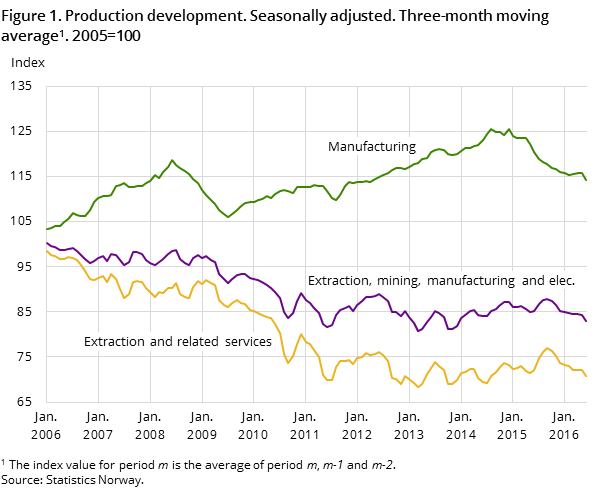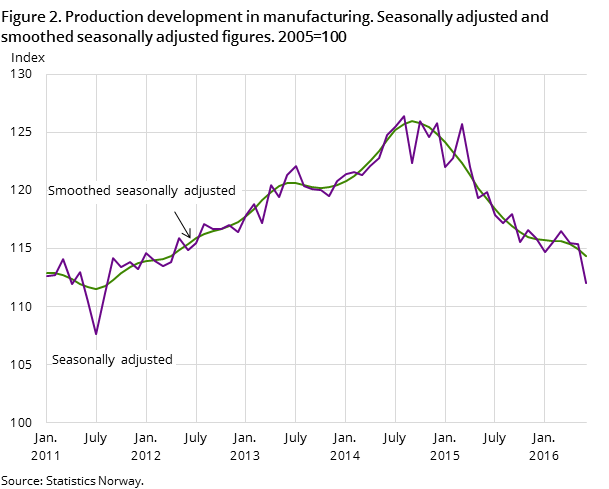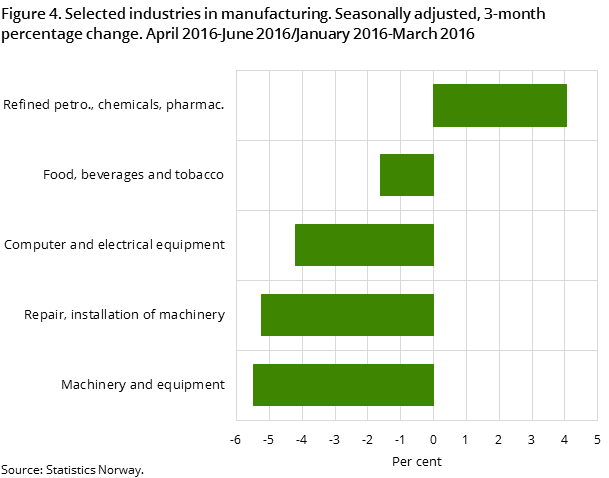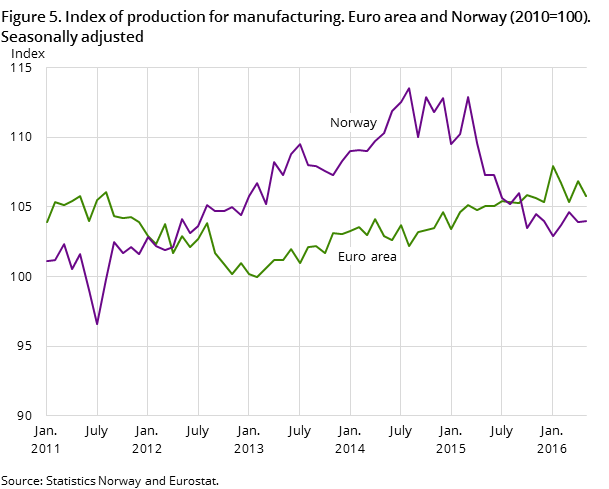Content
Published:
This is an archived release.
As from 23 September, all of Statistics Norway’s statistics will be released at 8am.
Manufacturing output down in second quarter
Norwegian manufacturing output decreased by 1.1 per cent in the second quarter of 2016, compared to the first quarter, according to seasonally-adjusted figures. The industries closely connected to the petroleum industry in particular contributed to this decline. From May to June 2016, manufacturing output saw a decline of 2.9 per cent.
| Seasonally adjusted | Calendar adjusted1 | Weights2 | ||
|---|---|---|---|---|
| Monthly change | Three-month change | Twelve-month change | ||
| June 2016 / May 2016 | April 2016 - June 2016 / January 2016 - March 2016 | June 2016 / June 2015 | ||
| 1Adjusted for working-days and for public holidays in Norway. | ||||
| 2The weights are updated annually, and are valid for the entire year. | ||||
| Extraction, mining, manufacturing and elec | -5.1 | -1.9 | -8.7 | 100.0 |
| Extraction and related services | -6.9 | -1.9 | -11.4 | 71.4 |
| Mining and quarrying | 1.4 | 3.1 | -7.2 | 0.5 |
| Manufacturing | -2.9 | -1.1 | -6.5 | 23.1 |
| Food, beverage and tobacco | -0.6 | -1.6 | -2.0 | 4.7 |
| Refined petro., chemicals, pharmac. | -0.8 | 4.0 | 9.2 | 2.4 |
| Basic metals | -0.9 | 0.5 | 3.0 | 1.2 |
| Machinery and equipment | -5.2 | -5.5 | -22.6 | 3.0 |
| Ships, boats and oil platforms | -2.2 | 2.8 | -2.8 | 1.8 |
| Electricity, gas and steam | -0.7 | -5.1 | -1.0 | 4.9 |





The index level for Norwegian manufacturing in the second quarter of 2016 amounted to 114.3 (2005=100). The corresponding figure for the first quarter was 115.6.
Three-month change: decline in machinery and equipment largest contributor to the downturn
According to seasonally-adjusted figures, the manufacturing output saw a decline of 1.1 per cent in the second quarter of 2016, compared to the previous quarter. Machinery and equipment contributed the most to this downturn, with a decline of 5.5 per cent. Repair and installation of machinery, together with computer and electrical equipment, decreased by 5.2 and 4.2 per cent respectively. These industries are all closely related to the oil and gas industry, and continue to be affected by the low investment activity within this industry.
On the contrary, refined petroleum, chemical and pharmaceutical products saw an increase of 4.0 per cent in the same quarter. Furthermore, building of ships and oil platforms increased by 2.8 per cent in the same quarter and wood and wood products increased by 4.4 per cent. This dampened the overall decline in the second quarter.
Monthly change: broad decline in manufacturing
Seasonally-adjusted figures show a decline of 2.9 per cent in manufacturing output from May to June 2016. All manufacturing industries experienced a decline, with the exception of wood and wood products. The largest contribution to the decline came from machinery and equipment, which fell by 5.2 per cent. At the same time, reduced output within the industries computer and electrical equipment, basic chemicals and food products also contributed to the overall decline from May to June 2016.
Twelve-month change: drop in Norway, growth in the euro area in May 2016
According to calendar-adjusted figures, Norwegian manufacturing output fell by 3.4 per cent from May 2015 to May 2016. Machinery and equipment contributed the most to this decline, together with repair and installation of machinery. Estimated figures from Eurostat, the EU`s statistical office, indicate that production in manufacturing in the euro area increased by 0.6 per cent in the same period.
Three-month change: reduction in total industrial production (PPI)
According to seasonally-adjusted figures, the overall production index (PII) covering extraction, mining, manufacturing and electricity supply decreased by 1.9 per cent in the second quarter of 2016 compared to the previous quarter. Extraction of crude petroleum decreased by 4.4 per cent, while extraction of natural gas increased by 1.2 per cent. For more details about oil and gas extraction for June 2016, see the press release from The Norwegian Petroleum Directorate.
Support activities for petroleum and natural gas extraction saw a production increase equivalent to 5.7 per cent in the second quarter compared to the first quarter of 2016. This was partly due to increased output in some central businesses within this industry in the second quarter, as well as especially low activity within this industry in the first quarter. On the other hand, output within the Norwegian electricity supply declined by 5.1 per cent, while mining and quarrying increased by 3.1 per cent.
Numbers for Services in oil and gas extraction is now in the data bankOpen and readClose
From October 2015, figures for Services in oil and gas extraction are published. According to SIC2007, Services in oil and gas extraction is grouped in section B Mining and quarrying. Producers within this industry supply, among other things, services related to drilling in exploration, appraisal and production wells, together with other services related to offshore activities such as installation of floating and fixed structures both above and below the sea floor. The time series is from the year 2010. This industry has always been a part of the aggregate Extraction and related services, but now its time series is also published separately in the data bank and tables.
On the effect of EasterOpen and readClose
It is important to be aware that the uncertainty for the calendar-adjusted and seasonally-adjusted indices for March and April is greater than normal due to the changed placing of Easter. This effect will also affect the seasonally-adjusted figures for the 1st and 2nd quarters. This is accounted for when adjusting for seasonal variations. However, it can still be difficult to adjust for all impacts.
Contact
-
Production and turnover
E-mail: prodoms@ssb.no
